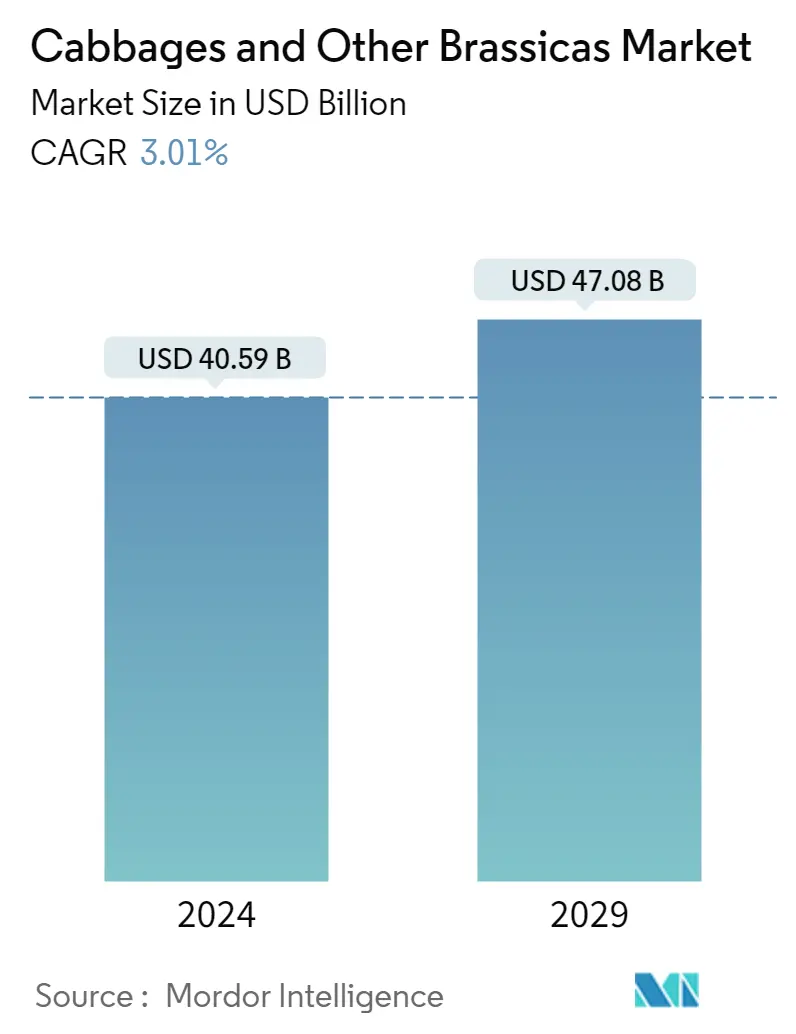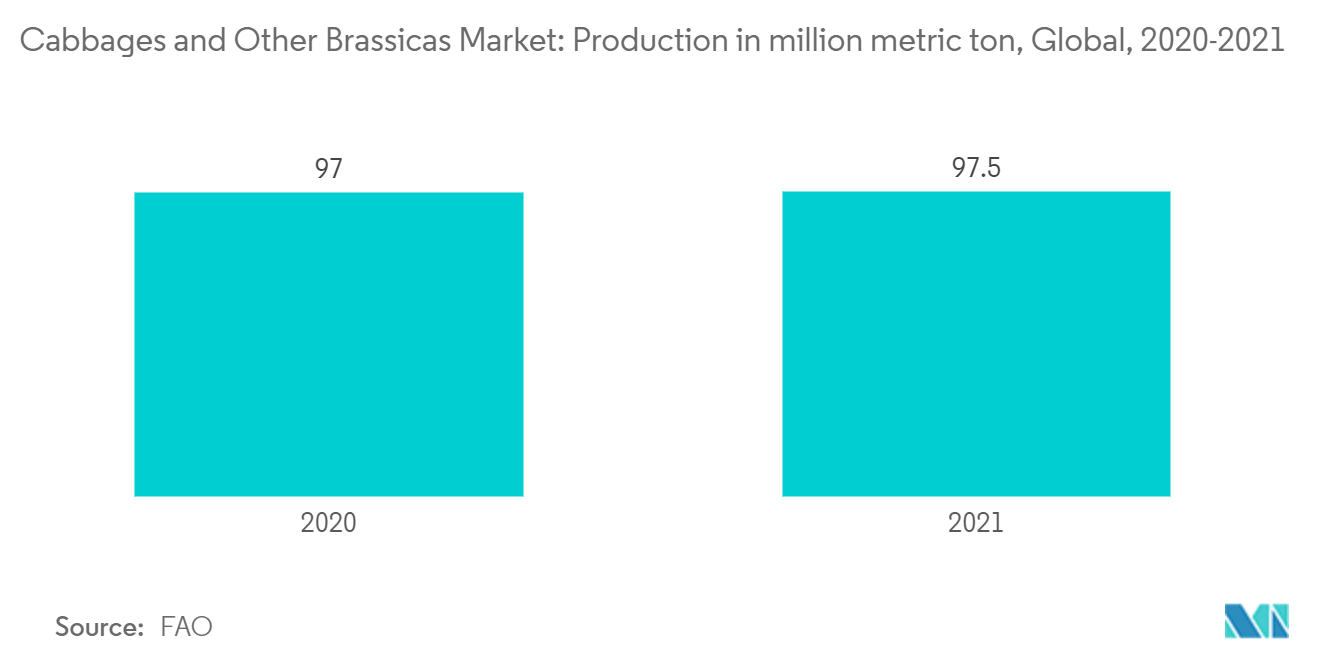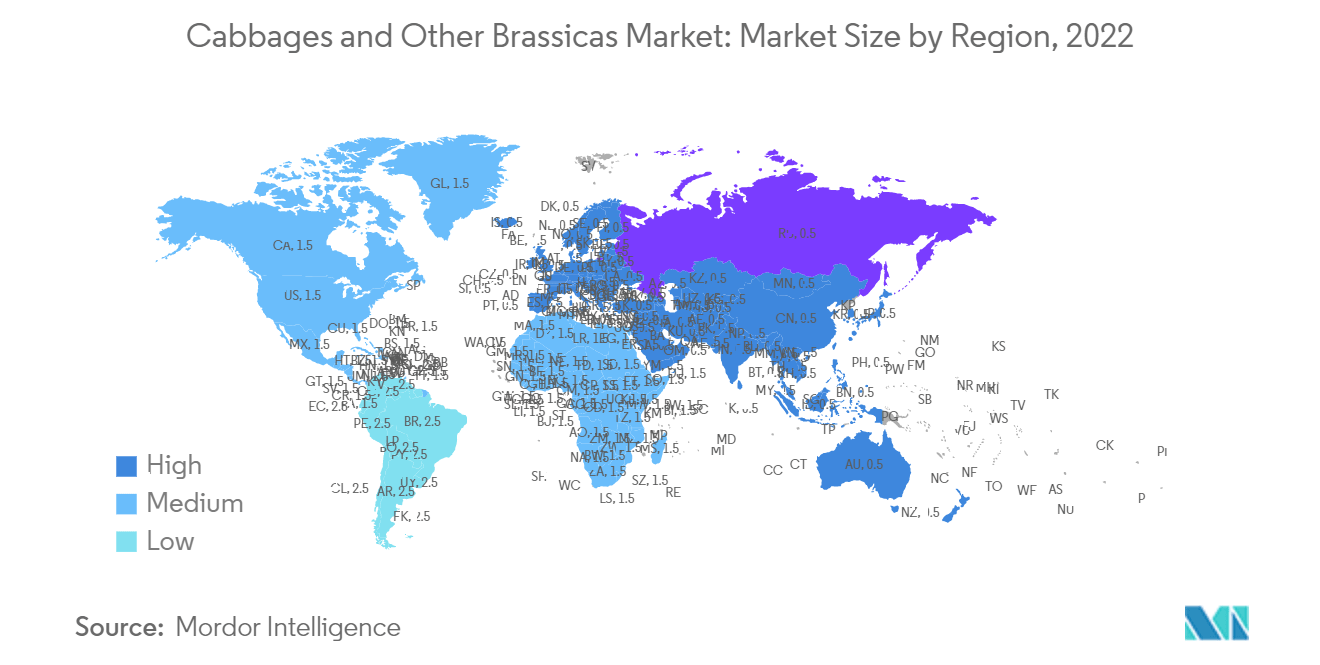Cabbages & Other Brassicas Market Size

| Study Period | 2019 - 2029 |
| Market Size (2024) | USD 40.59 Billion |
| Market Size (2029) | USD 47.08 Billion |
| CAGR (2024 - 2029) | 3.01 % |
| Fastest Growing Market | Asia Pacific |
| Largest Market | Asia Pacific |
Major Players*Disclaimer: Major Players sorted in no particular order |
Cabbages & Other Brassicas Market Analysis
The Cabbages and Other Brassicas Market size is estimated at USD 40.59 billion in 2024, and is expected to reach USD 47.08 billion by 2029, growing at a CAGR of 3.01% during the forecast period (2024-2029).
- There are three major types of cabbage, Brassica oleracea, green, red, and savoy. It belongs to the same plant family as many other vegetables, including Chinese cabbage and broccoli. The annual per capita consumption of fresh cabbage in 2021 averaged 5.9 pounds per person in the United States. Cole crops, such as broccoli, brussels sprouts, cabbage, and cauliflower, are extensively grown in South Carolina because weather conditions suit their growth.
- Currently, cabbage has a relevant position in the culture of many countries mainly due to its fiber content, minerals (Ca, P, and K), and vitamins (C, K, A, and folate). It is usually consumed fresh in salads, boiled, stir-fried, or fermented. It forms an essential part of the human diet because of its affordability and availability in local markets. Cabbage and other brassicas have the functional potential to regulate glucose levels and improve health in people.
- The market is expected to increase during the forecast period as the demand for cabbage and other brassica is increasing in the processing industry (Napa cabbage is much stringier than regular green cabbage and therefore is more suited to the lactic acid fermentation process in making kimchi and in the processing industries cabbages are used for making pickles) thereby increasing the cultivation area across the world. For instance, the area under brassicas increased from 3.7 million hectares in 2018 to 3.8 million hectares in 2021.
Cabbages & Other Brassicas Market Trends
Increasing Productivity Due to Adoption of New Irrigation Technologies
- Cabbage is a widely cultivated vegetable, but it requires efficient water management to ensure successful production. With a critical irrigation period during the last 3 to 4 weeks before harvest, cabbage has been classified as immediately susceptible to water stress.
- Optimum soil moisture of 75-80% and even 90% during the growth and maturation of the heads, as well as a relative air humidity of 85-90%, are crucial for the cabbage to thrive. Water requirements for cabbage vary from 380 mm to 500 mm depending on the climate and length of the growing season. The most widely adopted irrigation techniques for cabbage production worldwide include furrow, sprinkler, and trickle irrigation.
- The efficient use of these irrigation techniques drives the overall cabbages and other brassicas market. Technological advancements have led to the increased worldwide production of cabbages across the globe, which increased from 70.6 million metric tons in 2019 to 71.7 million metric tons in 2021. This growth is attributed to increased precision irrigation techniques and improved plant genetics and crop management practices. As the world population grows, the demand for healthy and nutritious food products such as cabbage is expected to rise, leading to increased production and investment in the cabbage industry.
- Efficient water management is crucial for successful cabbage production, and the adoption of precision irrigation techniques has led to increased cabbage production worldwide. As the demand for healthy and nutritious food products rises, the cabbage market is expected to grow, providing opportunities for investment and innovation in the industry.

Asia Pacific Leads the Global Cabbages and Other Brassicas Production
- Asia-Pacific has witnessed the highest production of cabbages and other brassicas, with China being the leading country in production and export. China is the largest exporter of cabbages and other brassicas globally, accounting for 34% of global exports in 2021. Of the total cabbage being exported, 97% is directed to the European Union countries, especially Germany, famous for Sauerkraut (fermented cabbage). With the gradual increase in the cabbage trade, the cabbage market is anticipated to increase in all the cabbage-producing provinces.
- In China, the state of Guangdong and the Yangtze River delta region are the key cabbage producers. The top five export destinations for "cabbages, cauliflowers, kohlrabi, kale, and similar edible brassicas, fresh or chilled" from China in 2021 are Hong Kong, Vietnam, Malaysia, Thailand, and Russia, with a combined share of 35% (USD 276 million), 26% (USD 208 million), and 20% (USD 67 million), and 8.51% (USD 23 million). In 2021, other brassicas production was dominated by Asia pacific region with 20.6 million metric tons, North America with 1.0 million metric tons, and Africa with 0.4 million metric tons.

Cabbages & Other Brassicas Market News
- January 2021: Rijk Zwaan company developed a new kind of cabbage variety for salad called Cabbisi, which is rich in Vitamin K and antioxidants.
- July 2021: AeroFarms expanded its business by introducing microgreens such as micro broccoli, a rich sulforaphane source that strengthened the market share of the company.
- October 2020: The United States Department of Agriculture's (USDA) National Institute of Food and Agriculture awarded a USD 2.7 million Specialty Crop Research Initiative (SCRI) grant to UGA College of Agricultural and Environmental Sciences faculty to study the Alternaria pathogens' biology, population structure, and fungicide resistance in broccoli.
Cabbages & Other Brassicas Market Report - Table of Contents
1. INTRODUCTION
- 1.1 Study Assumptions and Market Definition
- 1.2 Scope of the Study
2. RESEARCH METHODOLOGY
3. EXECUTIVE SUMMARY
4. MARKET DYNAMICS
- 4.1 Market Overview
- 4.2 Market Drivers
- 4.3 Market Restraints
- 4.4 Value Chain/Supply Chain Analysis
5. MARKET SEGMENTATION
-
5.1 Geography
- 5.1.1 North America
- 5.1.1.1 United States
- 5.1.1.1.1 Production Analysis
- 5.1.1.1.2 Consumption Analysis
- 5.1.1.1.3 Import Market Analysis
- 5.1.1.1.4 Export Market Analysis
- 5.1.1.1.5 Price Trend Analysis
- 5.1.1.2 Canada
- 5.1.1.2.1 Production Analysis
- 5.1.1.2.2 Consumption Analysis
- 5.1.1.2.3 Import Market Analysis
- 5.1.1.2.4 Export Market Analysis
- 5.1.1.2.5 Price Trend Analysis
- 5.1.2 Europe
- 5.1.2.1 Ukraine
- 5.1.2.1.1 Production Analysis
- 5.1.2.1.2 Consumption Analysis
- 5.1.2.1.3 Import Market Analysis
- 5.1.2.1.4 Export Market Analysis
- 5.1.2.1.5 Price Trend Analysis
- 5.1.2.2 Poland
- 5.1.2.2.1 Production Analysis
- 5.1.2.2.2 Consumption Analysis
- 5.1.2.2.3 Import Market Analysis
- 5.1.2.2.4 Export Market Analysis
- 5.1.2.2.5 Price Trend Analysis
- 5.1.2.3 Germany
- 5.1.2.3.1 Production Analysis
- 5.1.2.3.2 Consumption Analysis
- 5.1.2.3.3 Import Market Analysis
- 5.1.2.3.4 Export Market Analysis
- 5.1.2.3.5 Price Trend Analysis
- 5.1.2.4 United Kingdom
- 5.1.2.4.1 Production Analysis
- 5.1.2.4.2 Consumption Analysis
- 5.1.2.4.3 Import Market Analysis
- 5.1.2.4.4 Export Market Analysis
- 5.1.2.4.5 Price Trend Analysis
- 5.1.2.5 France
- 5.1.2.5.1 Production Analysis
- 5.1.2.5.2 Consumption Analysis
- 5.1.2.5.3 Import Market Analysis
- 5.1.2.5.4 Export Market Analysis
- 5.1.2.5.5 Price Trend Analysis
- 5.1.3 Asia-Pacific
- 5.1.3.1 China
- 5.1.3.1.1 Production Analysis
- 5.1.3.1.2 Consumption Analysis
- 5.1.3.1.3 Import Market Analysis
- 5.1.3.1.4 Export Market Analysis
- 5.1.3.1.5 Price Trend Analysis
- 5.1.3.2 India
- 5.1.3.2.1 Production Analysis
- 5.1.3.2.2 Consumption Analysis
- 5.1.3.2.3 Import Market Analysis
- 5.1.3.2.4 Export Market Analysis
- 5.1.3.2.5 Price Trend Analysis
- 5.1.3.3 South Korea
- 5.1.3.3.1 Production Analysis
- 5.1.3.3.2 Consumption Analysis
- 5.1.3.3.3 Import Market Analysis
- 5.1.3.3.4 Export Market Analysis
- 5.1.3.3.5 Price Trend Analysis
- 5.1.3.4 Japan
- 5.1.3.4.1 Production Analysis
- 5.1.3.4.2 Consumption Analysis
- 5.1.3.4.3 Import Market Analysis
- 5.1.3.4.4 Export Market Analysis
- 5.1.3.4.5 Price Trend Analysis
- 5.1.3.5 Uzbekistan
- 5.1.3.5.1 Production Analysis
- 5.1.3.5.2 Consumption Analysis
- 5.1.3.5.3 Import Market Analysis
- 5.1.3.5.4 Export Market Analysis
- 5.1.3.5.5 Price Trend Analysis
- 5.1.3.6 Indonesia
- 5.1.3.6.1 Production Analysis
- 5.1.3.6.2 Consumption Analysis
- 5.1.3.6.3 Import Market Analysis
- 5.1.3.6.4 Export Market Analysis
- 5.1.3.6.5 Price Trend Analysis
- 5.1.4 South America
- 5.1.4.1 Chile
- 5.1.4.1.1 Production Analysis
- 5.1.4.1.2 Consumption Analysis
- 5.1.4.1.3 Import Market Analysis
- 5.1.4.1.4 Export Market Analysis
- 5.1.4.1.5 Price Trend Analysis
- 5.1.4.2 Peru
- 5.1.4.2.1 Production Analysis
- 5.1.4.2.2 Consumption Analysis
- 5.1.4.2.3 Import Market Analysis
- 5.1.4.2.4 Export Market Analysis
- 5.1.4.2.5 Price Trend Analysis
- 5.1.5 Africa
- 5.1.5.1 South Africa
- 5.1.5.1.1 Production Analysis
- 5.1.5.1.2 Consumption Analysis
- 5.1.5.1.3 Import Market Analysis
- 5.1.5.1.4 Export Market Analysis
- 5.1.5.1.5 Price Trend Analysis
- 5.1.5.2 Egypt
- 5.1.5.2.1 Production Analysis
- 5.1.5.2.2 Consumption Analysis
- 5.1.5.2.3 Import Market Analysis
- 5.1.5.2.4 Export Market Analysis
- 5.1.5.2.5 Price Trend Analysis
6. MARKET OPPORTUNITIES AND FUTURE TRENDS
** Subject To AvailablityCabbages & Other Brassicas Industry Segmentation
Cabbage is a leafy green, red (purple), or white (pale green) biennial plant grown as an annual vegetable crop for its dense leaved heads. Brassicas are members of the family of vegetables that includes broccoli, brussels sprouts, cabbage, cauliflower, collard greens, kale, and turnips.
The cabbages and other brassicas market is segmented by geography (North America, Europe, Asia-Pacific, South America, and Africa).
The report also offers the market sizing in terms of value (USD million) and volume (metric ton).
| Geography | North America | United States | Production Analysis |
| Consumption Analysis | |||
| Import Market Analysis | |||
| Export Market Analysis | |||
| Price Trend Analysis | |||
| Geography | North America | Canada | Production Analysis |
| Consumption Analysis | |||
| Import Market Analysis | |||
| Export Market Analysis | |||
| Price Trend Analysis | |||
| Geography | Europe | Ukraine | Production Analysis |
| Consumption Analysis | |||
| Import Market Analysis | |||
| Export Market Analysis | |||
| Price Trend Analysis | |||
| Geography | Europe | Poland | Production Analysis |
| Consumption Analysis | |||
| Import Market Analysis | |||
| Export Market Analysis | |||
| Price Trend Analysis | |||
| Geography | Europe | Germany | Production Analysis |
| Consumption Analysis | |||
| Import Market Analysis | |||
| Export Market Analysis | |||
| Price Trend Analysis | |||
| Geography | Europe | United Kingdom | Production Analysis |
| Consumption Analysis | |||
| Import Market Analysis | |||
| Export Market Analysis | |||
| Price Trend Analysis | |||
| Geography | Europe | France | Production Analysis |
| Consumption Analysis | |||
| Import Market Analysis | |||
| Export Market Analysis | |||
| Price Trend Analysis | |||
| Geography | Asia-Pacific | China | Production Analysis |
| Consumption Analysis | |||
| Import Market Analysis | |||
| Export Market Analysis | |||
| Price Trend Analysis | |||
| Geography | Asia-Pacific | India | Production Analysis |
| Consumption Analysis | |||
| Import Market Analysis | |||
| Export Market Analysis | |||
| Price Trend Analysis | |||
| Geography | Asia-Pacific | South Korea | Production Analysis |
| Consumption Analysis | |||
| Import Market Analysis | |||
| Export Market Analysis | |||
| Price Trend Analysis | |||
| Geography | Asia-Pacific | Japan | Production Analysis |
| Consumption Analysis | |||
| Import Market Analysis | |||
| Export Market Analysis | |||
| Price Trend Analysis | |||
| Geography | Asia-Pacific | Uzbekistan | Production Analysis |
| Consumption Analysis | |||
| Import Market Analysis | |||
| Export Market Analysis | |||
| Price Trend Analysis | |||
| Geography | Asia-Pacific | Indonesia | Production Analysis |
| Consumption Analysis | |||
| Import Market Analysis | |||
| Export Market Analysis | |||
| Price Trend Analysis | |||
| Geography | South America | Chile | Production Analysis |
| Consumption Analysis | |||
| Import Market Analysis | |||
| Export Market Analysis | |||
| Price Trend Analysis | |||
| Geography | South America | Peru | Production Analysis |
| Consumption Analysis | |||
| Import Market Analysis | |||
| Export Market Analysis | |||
| Price Trend Analysis | |||
| Geography | Africa | South Africa | Production Analysis |
| Consumption Analysis | |||
| Import Market Analysis | |||
| Export Market Analysis | |||
| Price Trend Analysis | |||
| Geography | Africa | Egypt | Production Analysis |
| Consumption Analysis | |||
| Import Market Analysis | |||
| Export Market Analysis | |||
| Price Trend Analysis |
Cabbages & Other Brassicas Market Research FAQs
How big is the Cabbages and Other Brassicas Market?
The Cabbages and Other Brassicas Market size is expected to reach USD 40.59 billion in 2024 and grow at a CAGR of 3.01% to reach USD 47.08 billion by 2029.
What is the current Cabbages and Other Brassicas Market size?
In 2024, the Cabbages and Other Brassicas Market size is expected to reach USD 40.59 billion.
Which is the fastest growing region in Cabbages and Other Brassicas Market?
Asia Pacific is estimated to grow at the highest CAGR over the forecast period (2024-2029).
Which region has the biggest share in Cabbages and Other Brassicas Market?
In 2024, the Asia Pacific accounts for the largest market share in Cabbages and Other Brassicas Market.
What years does this Cabbages and Other Brassicas Market cover, and what was the market size in 2023?
In 2023, the Cabbages and Other Brassicas Market size was estimated at USD 39.40 billion. The report covers the Cabbages and Other Brassicas Market historical market size for years: 2019, 2020, 2021, 2022 and 2023. The report also forecasts the Cabbages and Other Brassicas Market size for years: 2024, 2025, 2026, 2027, 2028 and 2029.
Cabbages and Other Brassicas Industry Report
Statistics for the 2024 Cabbages and Other Brassicas market share, size and revenue growth rate, created by Mordor Intelligence™ Industry Reports. Cabbages and Other Brassicas analysis includes a market forecast outlook to 2029 and historical overview. Get a sample of this industry analysis as a free report PDF download.



